2008 Suzuki Gsx
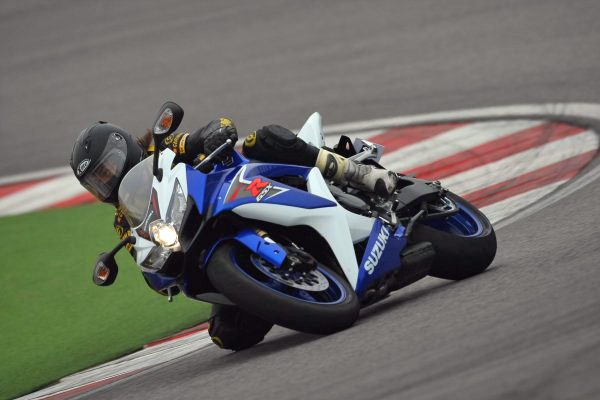
We meet again, and this time around it's at the modified Santa Monica Adriatico racetrack, a circuit that now runs in the opposite direction and features a new more technical section that further challenges and entices riders. Two days of testing are complicated by weather conditions, cold and wet asphalt and temperatures that don't climb beyond 43-degrees Fahrenheit. How will the new Suzuki GSX-R 600 behave under these conditions?
Before eliminating any doubts, we'll see what the new 2008 version offers and what improvements have been realized over the previous bike. For starters, the bike has some significant design changes. The fairings, cowling, fuel tank, seat, and lights are all new. These innovations combine to give the bike more style, improve aerodynamics, and improve seating position and rider comfort.
The seat is slightly narrower. The windshield has grown in size and protects more completely. The footpegs are again adjustable. Side multi-reflector headlights expand the lighting area to improve visibility in corners and a central light now offers a brighter and wider beam. In back, the taillights are now quicker responding and with brighter LEDs. If we continue on to the actual bike chassis, there are a few minor changes designed to give the bike greater manageability and a sportier feel. The rear shock absorber now features a high-speed and low-speed damping adjustment for more precise settings. The shock can also be adjusted for height and for spring preloading. In front, an electro-hydraulic steering damper adjusts automatically according to speed and controls the lighter weight (0.66 pounds) of the new wheels and tires. These changes greatly augment the bike's maneuverability and stability under acceleration.
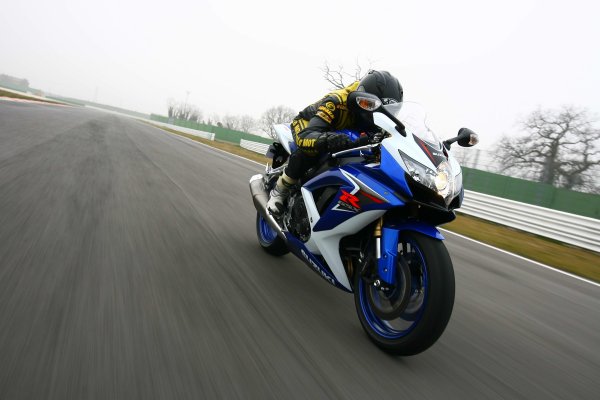
As for the brakes, the rotors may be the same diameter as before, but more attachment points to the floating rotors improve cooling and fade resistance despite a half-millimeter decrease in rotor width. The front brake calipers from Tokico are also modified and now feature smaller pistons that reduce weight.
The engine is the sight of more changes. The objective, according to Suzuki, has been to improve low-speed and mid-range performance without losing power at the top end of the rev range.
To this end, the openings that connect the cylinders are 41-millimeters larger in diameter to lower piston pressures, and there are now two fuel injectors per cylinder. Each injector features eight holes that improve the spray pattern and atomize the fuel more effectively-the result is improved emissions through more complete combustion. The intake manifold is now longer in length and features two throttle butterflies (SDTV) that speed the intake charge.
To boost mid-range power, valve-timing has been changed and a new exhaust that features a butterfly valve in the mid pipe.
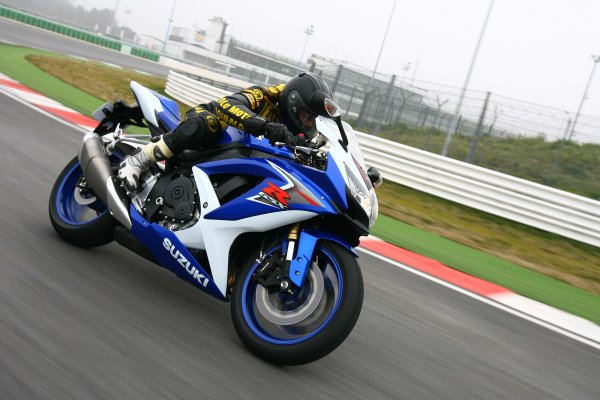
The most interesting and prominent changes come by way of electronics. Following the example of its larger brother, the GSX-R 1000, the GSX-R 600 comes with three selectable power settings at the push of a button . . . a instrument-mounted indicator keeps track of which setting the bike is in. In mode "A" one gets all the power as quickly as possible, mode "B" delays power delivery, particularly in the mid-range. Finally, mode "C" reduces engine power throughout the rev range. This final mode is most effective when road conditions are less than ideal.
Clutch design has also evolved to offer improved actuation that is both smoother and more effective than before. Gear changes in the low- to medium-rev range are more responsive than before.
Despite the cold weather and the less-than-ideal track conditions for all-out riding, your dedicated protagonist looks past the weather to enjoy a vibrant and emotional ride. The tarmac is cold, but tire warmers provide some heat to the homologated Bridgestone BT016 tires. The first laps of the morning session of the first day are the only time that calls for the power-reducing mode "C". After getting more confident on the wet and cold pavement, I move up to mode "B". Once the grip increases and I spot dry patches I call up full power, mode "A".
The motorcycle is a surprise, not only because of the various power-delivery settings, but for many other reasons. I am immediately impressed with the ergonomics, space, and freedom of body movement. Each time I brake I find myself braking harder and closer to the corner entry, and I quickly grow accustomed to the bike's performance thanks to the communicative controls and confidence inspiring feel.
A gentle squeeze of the brakes is all it takes to haul the GSX-R down from speed and the braking performance never fades. The bike is well-mannered, yet eminently powerful. I'm not yet accelerating at full throttle, but the stability of the bike boosts my confidence. Cornering stability is first-rate; the bike is tossable, responsive, and can be thrown about with authority, if one is so inclined.
I finish the first session and check the tire temperatures. Ouch! I only get up to 102-degrees Fahrenheit in the front tire and 108-degrees in back . . . about half of what the tires prefer. But at least I made it through the session without scaring myself.
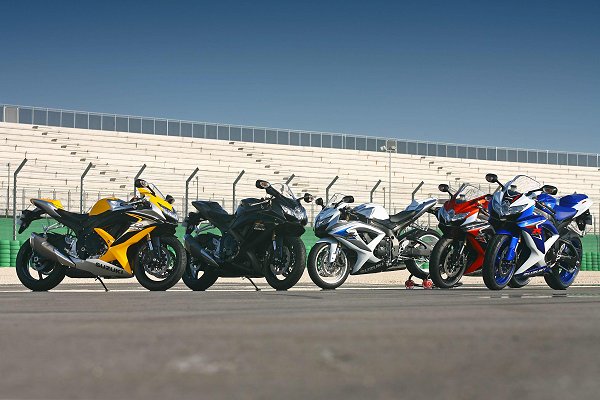
The next session the track has dried completely, although the surface remains cold. I go back out with confidence and immediately start pushing the bike in an attempt to make the most of the heat provided by the tire warmers. I find myself using all of the engine's revs (in mode "A") and find the powerband extremely broad. It is most impressive from 9000 RPM to the redline at 16,000 RPM.
I rarely dip below 9000 RPM, except for the complicated section of curves at the exit of the "Carro". Exiting this section, I find that the engine is quick to return to the optimum rev-range without any fuss. The acceleration is energetic and the power delivery is elastic; thanks to the slipper clutch action the bike remains stable under braking. "My word! This bike will take anything you throw at it!" I have to mention the excellent slipper clutch operation, because it gives me the confidence and security to make mistakes without having to suffer any consequences. Under the load of full-throttle acceleration, the rear tire begins to slip and the rear shock nearly bottoms. Despite this, the rear of the bike never steps out or does anything unsettling.
 I'm very appreciative of the wind protection from the redesigned fairing during a knee-down corner taken at 143 MPH. I finish that session satisfied that I was able to maintain a good rhythm and speed. The rest of the day and on the second day, conditions continue to improve, and I am able to turn faster laps. Despite my increased speed, I don't approach the limits of the bike . . . I just keep finding more grip and speed.
I'm very appreciative of the wind protection from the redesigned fairing during a knee-down corner taken at 143 MPH. I finish that session satisfied that I was able to maintain a good rhythm and speed. The rest of the day and on the second day, conditions continue to improve, and I am able to turn faster laps. Despite my increased speed, I don't approach the limits of the bike . . . I just keep finding more grip and speed.
I assure you that this engine ups the ante in its class. This is an effortless and seamless powerplant that creates a fantastic sound and has a furious mien. Beyond the engine performance, the new GSX-R600 handles supremely, and continually asks the rider to push it harder.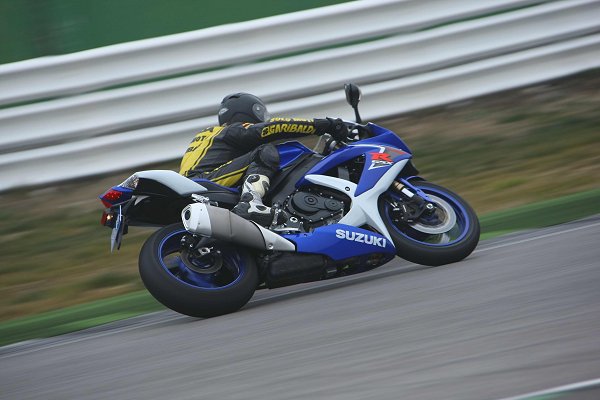
Pluses
- Impressive power at medium and high RPM, flexible and elastic power delivery is a surprise
- Electronic power selector
- The slipper clutch is a great aid under braking
- Maneuverability, strong and responsive brakes, optimal riding position
- Adjustable footrests
- The new fairing protects the rider from the elements
Minuses
- The engine is best enjoyed at high RPMs
- Lacks clutch lever adjustment and a fuel-level gauge
You can follow any responses to this entry through the RSS 2.0 feed. Both comments and pings are currently closed.
Source: https://www.motorcycledaily.com/2008/03/13march08_2008_suzuki_gsxr600/







Tidak ada komentar:
Posting Komentar